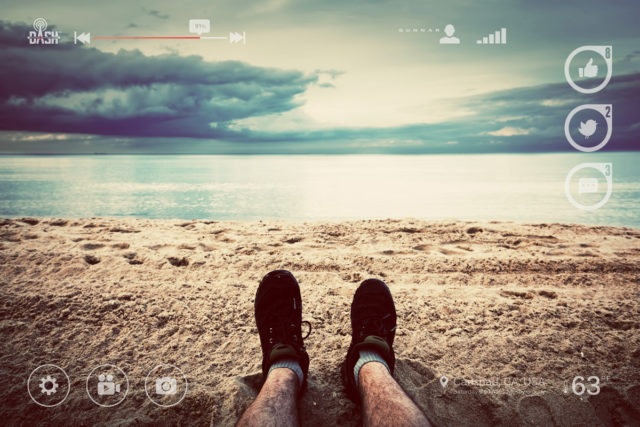Things disappear from our workspace and pockets of clothes. In 20 years nothing will remain there.

From the seventies of the last century to the present day, many familiar office tools have been 'absorbed', such as calendars, Rolodex filing cabinets, dictionaries, maps, books, media players, filing cabinets, fax machines and corded telephones.
Most legacy office devices are already widely emulated via a networked smartphone or laptop. The arsenal of a typical tech company employee now includes a laptop with a charger, a smartphone, headphones, a wallet or bag and keys.
The process of extinction, unnoticed by everyone, was initiated in the era of the PC. Soon it will be possible to go to a coffee shop without a phone or laptop charger and surf the Internet, chat with friends in video or edit tables. By the mid-twenties of this century, you will no longer need your keys, wallet and laptop. The keys will be taken over by smartphones already in 2017, in which Volvo will launch cars in which it will be possible to control the door opening and engine start using a smartphone. Most cars will have this functionality by 2025. The laptop charger will be at home at all times as laptop battery life has increased over the past fifteen years. With a breakthrough in mobile technology, flagship laptops will go beyond 12 hours of battery life.

Also, two key items from our wallets will go to the smartphone – a driver's license and a credit card. In one of the US states, a pilot project for issuing driver's licenses to a smartphone has started. The battle for digital payments via smartphones is ongoing, with Visa, MasterCard, Apple Pay, Samsung Pay and Google Wallet taking part.
The coming era of smart glasses
In the thirties, laptops, smartphones and headphones will be combined into smart glasses. Unlike Google Glass, which was essentially just an external display, these glasses will completely replace your smartphone. Two major technological breakthroughs will be responsible for their work – augmented reality displays and finger tracking technologies. Innovations in miniaturization and rechargeable batteries will deliver hundreds of times the performance of your current smartphone, and headphones will be built into the temples.
The augmented reality display in smart glasses will display text, images and full 3D scenes directly in the user's field of view. Everything that we can see through the monitor today will be available in three-dimensional quality in smart glasses. So fifteen years later, during our regular gatherings at Starbucks, we will use a high-resolution virtual monitor that will look like a real one. Accelerometers and motion sensors will 'tie' the monitor to the table. Augmented reality displays allow us to create any work surface we want. The standard configuration will probably include a virtual display of three monitors, coupled with a graphics tablet on the table.
The glasses will integrate finger tracking technology, which is currently being demonstrated by the Xbox Kinect and Leap Motion, eliminating the need for a keyboard and mouse. The smart glasses will project a smart keyboard onto any surface, and finger tracking will recognize virtual keystrokes, most likely with audible pressure indication. We have already seen a similar transition from tactile mobile keyboards (BlackBerry) to touch screens (iOS and Android).

No more screens
Some may refuse to wear glasses for reasons of appearance. There is no reason to worry, because by the end of the 40s of the 21st century, 'smart' glasses will give way to augmented reality contact lenses, which will be supplemented by a tiny processor implanted in the shoulder by a surgical method. The earbuds will also be available as permanent inserts, allowing online communication anywhere, anytime, without peripherals. Google (MagicLeap) and Microsoft (HoloLens) are pushing for augmented reality displays. The first results are rather clumsy and similar to a Compaq computer from the 1980s. But there is a lot at stake. The winner of this battle will single-handedly determine the future of screens as a category and open the door to a new era in which all screens will be virtual.
Original material by David Bazhuki, creator, co-founder and CEO of Roblox
The author cannot be denied fantasy, as well as a certain, so to speak, technological utopian character of the narrative. Nevertheless, the described prospects do not seem to be something super-fantastic, the speed of technology development is unpredictable. The described scenarios, despite their seeming realism, raise many questions regarding the implementation of a particular project. Perhaps the main problem will be the need to get rid of the existing layer of devices, this will take an extremely long time, especially when it comes to developing markets of the third world countries. Well, no one has forgotten the sad fate that befell Google Glass, such an experience cannot be ignored.
The trend towards the 'absorption' of some devices by others cannot go unnoticed. Modern offices have gotten rid of mountains of papers and bulky machines, in my opinion, a positive trend. Screen virtualization is also quite interesting, but monitor manufacturers will be oh, how not happy about such innovations and this will significantly slow down the breakthrough mentioned by the author, the real world is not so quick to agree to 'friendship' with augmented reality in all its manifestations. I would be glad to be wrong.
